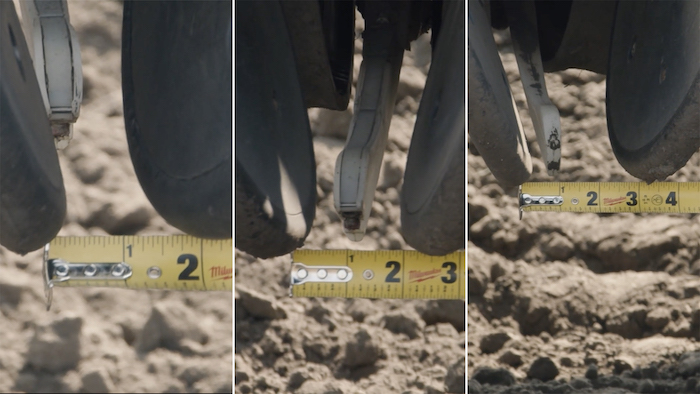1. Check for Proper Alignment
It’s important that you check your closing system to ensure it closes the furrow for good seed to soil contact.
To check for proper alignment, start by going back to the closing tail and feeling for any side-to-side motion. If you feel an excessive amount of side-to-side motion, it’s time to check the bushings and the mounting holes of the closing tail itself. If necessary, replace those components.
2. Make Sure the Closing Tail is Centered
Once you have the closing tail tightly aligned set the planter down on a pad of concrete, roll forward about 3 feet, and make a mark. You can then use that center line in the concrete to be sure that you’re centered in the closing tail. If you’re not, adjust the closing tail.
Different closing systems will have different adjustments. In this example, we’re going to loosen two nuts underneath, pivot the tail side-to-side, and tighten it down to be sure it’s trailing properly. It’s best to do this before you go to the field.
3. Measure the Distance Between Wheels
Now that you have the closing tail set and centered properly look at your distance between the closing wheels to ensure that you’re going to get the best closure of the trench that you can.

Here are the different extremes for closing wheels. In the first photo, you can see these have been set too narrow. Measuring from the bottom center radius to the bottom center radius there is about 1 ½ inches. This narrow setting will tend to pinch the top of the trench but leave an air gap around the seed at the bottom. In this environment, emergence will be delayed.
The other extreme is set at 3 ½ inches from bottom center to bottom center. This is going to tend to close towards the bottom of the trench, but you’re not going to get the top of that trench closed. You’re going to risk leaving an open furrow.
In between is the optimal setting if you’re planting in that 2 to 2 ½ inch range. If you look at 2 ½ inches from bottom center to bottom center, this tends to center those forces down the edge of each sidewall and completely encapsulate that seed in the moisture beneath, at typical corn planting depths.
Watch Precision Planting's video about closing wheel spacing.
4. Check Your Closing Spring Tension
The last check is to determine whether or not you can maintain the right amount of pressure in order to close the trench. To do this in a shop setting, you can take a bathroom scale, slide it underneath each row unit and lower the planter. Next, set each closing tail on the same notch. Be sure that each spring is still in good condition and applying the same amount of tension.
If you see that you’re getting a significant difference from row-to-row, it may be time to replace the springs on that closing tail to ensure that you’re applying the right amount of force. Once you get to the field, make sure that you dig a cross-section of the trench. Use a pocket knife or a hand hoe to go in and cut a cross-section of the trench. Pull it towards yourself and ensure that you’ve gotten rid of any air gaps around the seed without over-closing the furrow.
5. Eliminate the Guess Work
Setting your closing system correctly is tough. FurrowForce is a two-stage closing system that adapts to your planting conditions to remove air pockets and firm soil to keep moisture, giving you confidence that your crops will germinate the best that they can.
A Premier Precision Planting Dealer is your partner to help you achieve even emergence this spring and steer clear of the regret that comes from avoidable yield loss caused by lack of maintenance. Find your local Precision Planting Premier Dealer at planterexpert.com.
To watch videos of all recommended annual maintenance checks, visit PrecisionPlanting.com/Maintenance.
Download the free Planter Maintenance Guide. This guide includes a 1-sheet checklist, links directing you to the corresponding videos and an overview of 15 key maintenance areas on your planter.
The Planter Maintenance series is brought to you by Precision Planting.
For farmers who believe in better. Believing in better is a mindset to pursue excellence in everything you do. It’s welcoming opportunities to improve your farm and knowing that your best season is simply a starting point for this season. Precision Planting is for farmers like you who Believe in Better.








Post a comment
Report Abusive Comment